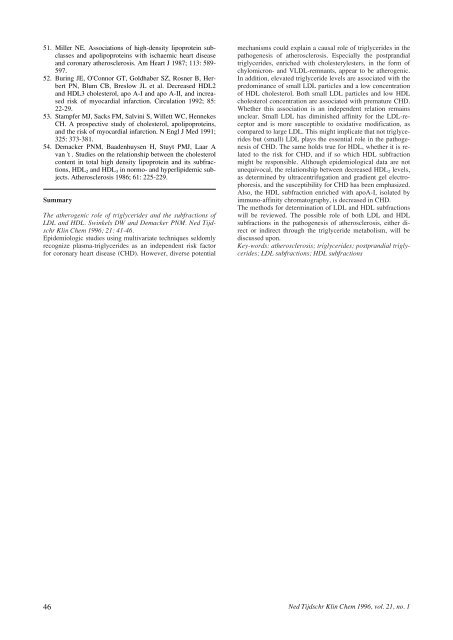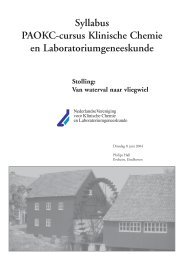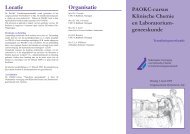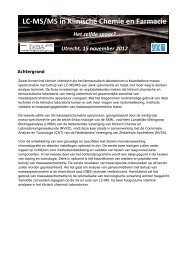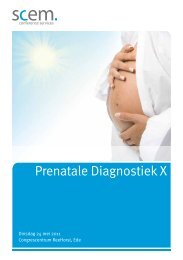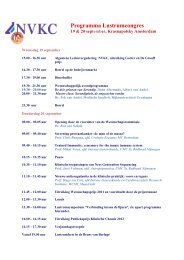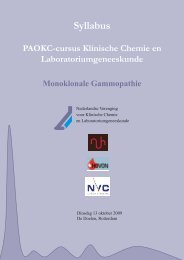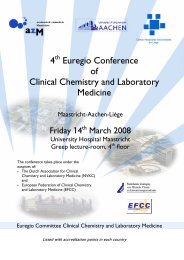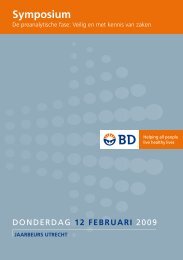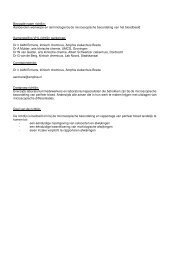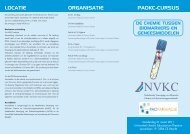De atherogene rol van triglyceriden, LDL- en HDL-subfracties - NVKC
De atherogene rol van triglyceriden, LDL- en HDL-subfracties - NVKC
De atherogene rol van triglyceriden, LDL- en HDL-subfracties - NVKC
You also want an ePaper? Increase the reach of your titles
YUMPU automatically turns print PDFs into web optimized ePapers that Google loves.
51. Miller NE. Associations of high-d<strong>en</strong>sity lipoprotein subclasses<br />
and apolipoproteins with ischaemic heart disease<br />
and coronary atherosclerosis. Am Heart J 1987; 113: 589-<br />
597.<br />
52. Buring JE, O'Connor GT, Goldhaber SZ, Rosner B, Herbert<br />
PN, Blum CB, Breslow JL et al. <strong>De</strong>creased <strong>HDL</strong>2<br />
and <strong>HDL</strong>3 choleste<strong>rol</strong>, apo A-I and apo A-II, and increased<br />
risk of myocardial infarction. Circulation 1992; 85:<br />
22-29.<br />
53. Stampfer MJ, Sacks FM, Salvini S, Willett WC, H<strong>en</strong>nekes<br />
CH. A prospective study of choleste<strong>rol</strong>, apolipoproteins,<br />
and the risk of myocardial infarction. N Engl J Med 1991;<br />
325: 373-381.<br />
54. <strong>De</strong>macker PNM, Baad<strong>en</strong>huys<strong>en</strong> H, Stuyt PMJ, Laar A<br />
<strong>van</strong> 't . Studies on the relationship betwe<strong>en</strong> the choleste<strong>rol</strong><br />
cont<strong>en</strong>t in total high d<strong>en</strong>sity lipoprotein and its subfractions,<br />
<strong>HDL</strong> 2 and <strong>HDL</strong> 3 in normo- and hyperlipidemic subjects.<br />
Atherosclerosis 1986; 61: 225-229.<br />
Summary<br />
The atherog<strong>en</strong>ic <strong>rol</strong>e of triglycerides and the subfractions of<br />
<strong>LDL</strong> and <strong>HDL</strong>. Swinkels DW and <strong>De</strong>macker PNM. Ned Tijdschr<br />
Klin Chem 1996; 21: 41-46.<br />
Epidemiologic studies using multivariate techniques seldomly<br />
recognize plasma-triglycerides as an indep<strong>en</strong>d<strong>en</strong>t risk factor<br />
for coronary heart disease (CHD). However, diverse pot<strong>en</strong>tial<br />
mechanisms could explain a causal <strong>rol</strong>e of triglycerides in the<br />
pathog<strong>en</strong>esis of atherosclerosis. Especially the postprandial<br />
triglycerides, <strong>en</strong>riched with cholesterylesters, in the form of<br />
chylomicron- and V<strong>LDL</strong>-remnants, appear to be atherog<strong>en</strong>ic.<br />
In addition, elevated triglyceride levels are associated with the<br />
predominance of small <strong>LDL</strong> particles and a low conc<strong>en</strong>tration<br />
of <strong>HDL</strong> choleste<strong>rol</strong>. Both small <strong>LDL</strong> particles and low <strong>HDL</strong><br />
choleste<strong>rol</strong> conc<strong>en</strong>tration are associated with premature CHD.<br />
Whether this association is an indep<strong>en</strong>d<strong>en</strong>t relation remains<br />
unclear. Small <strong>LDL</strong> has diminished affinity for the <strong>LDL</strong>-receptor<br />
and is more susceptible to oxidative modification, as<br />
compared to large <strong>LDL</strong>. This might implicate that not triglycerides<br />
but (small) <strong>LDL</strong> plays the ess<strong>en</strong>tial <strong>rol</strong>e in the pathog<strong>en</strong>esis<br />
of CHD. The same holds true for <strong>HDL</strong>, whether it is related<br />
to the risk for CHD, and if so which <strong>HDL</strong> subfraction<br />
might be responsible. Although epidemiological data are not<br />
unequivocal, the relationship betwe<strong>en</strong> decreased <strong>HDL</strong> 2 levels,<br />
as determined by ultrac<strong>en</strong>trifugation and gradi<strong>en</strong>t gel electrophoresis,<br />
and the susceptibility for CHD has be<strong>en</strong> emphasized.<br />
Also, the <strong>HDL</strong> subfraction <strong>en</strong>riched with apoA-I, isolated by<br />
immuno-affinity chromatography, is decreased in CHD.<br />
The methods for determination of <strong>LDL</strong> and <strong>HDL</strong> subfractions<br />
will be reviewed. The possible <strong>rol</strong>e of both <strong>LDL</strong> and <strong>HDL</strong><br />
subfractions in the pathog<strong>en</strong>esis of atherosclerosis, either direct<br />
or indirect through the triglyceride metabolism, will be<br />
discussed upon.<br />
Key-words: atherosclerosis; triglycerides; postprandial triglycerides;<br />
<strong>LDL</strong> subfractions; <strong>HDL</strong> subfractions<br />
46 Ned Tijdschr Klin Chem 1996, vol. 21, no. 1


